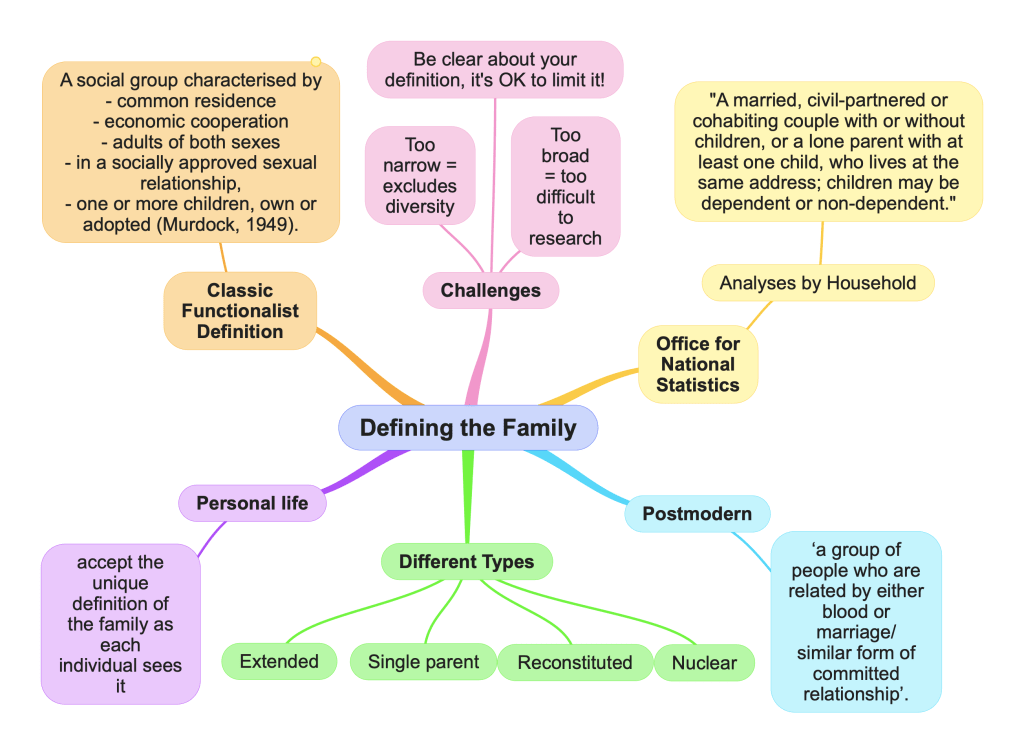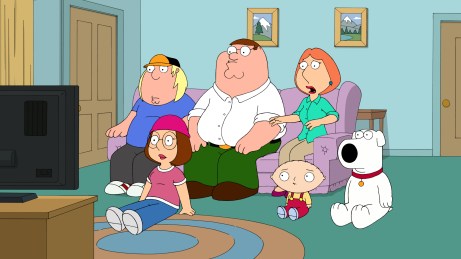
Functionalist sociologists tended to define the family as consisting of two parents in a committed relationship living together with their children. Postmodern and other sociologists have much broader definitions.
Table of Contents
Last Updated on June 12, 2023 by Karl Thompson
Sociologists do not agree on one standard definition of ‘the family’.
Functionalist sociologists traditionally used narrow definitions of the family, in which the family unit had to consist of a “man and a woman in a committed sexual relationship living together with their children“.
More contemporary Postmodern sociologists prefer much broader definitions of the family which extend the concept to include anyone an individual thinks of as being ‘part of the family’, such as friends or even pets.
From a postmodern perspective there is no ‘right’ or ‘wrong’ definition of the family, but you do need to know how different sociologists define the family to really understand their perspective on the family, and to be able to evaluate the different perspectives.
The rest of this introductory post explores how the concept of ‘the family’ has been used by different sociologists, and aims to get you thinking about what the family is.

It has been written as an introduction the Families and Households module for A-level sociology, AQA focus.
Functionalist Sociologist George Peter Murdock used the following definition of the family as a starting point in his classic cross national study of families in more than 250 societies.
‘A social group characterised by common residence, economic cooperation and reproduction. It includes adults of both sexes, at least two of whom maintain a socially approved sexual relationship, and one or more children, own or adopted, of the sexually cohabiting adults’ (Murdock, 1949).

Today, many Sociologists criticise the classic functionalist definition of the family as being too narrow because (both today and historically) too many groups of people who regard themselves as a family would not be included in this definition, such as reconstituted or step-families and same sex families.
A broader definition is provided by The Oxford English Dictionary which defines ‘the family’ as ‘a group consisting of one or two parents and their children’. (1)
The above definition includes step-families, single parent families and doesn’t even mention sex or sexual orientation of the parents, so includes same-sex families too.
We often think of families as living in one household, however the Oxford definition above says nothing at all about households, so in the above definition it’s feasible that a family spans multiple households, which, from the perspective of families themselves is quite normal.
For example, a couple in their 70s with one adult daughter who have moved out and is living on her own would probably all regard themselves as one family.
Similarly with families and households across the generations: grandparents are usually regarded as part of the broader or extended family, for example, and if grandparents and then parents each have two children, from the perspective of the older generation their family will extend across several households.
The problem with accepting these subjective definitions is that we quickly lose track of how many families there are, especially when we factor in divorce and step-families, the concept of family starts to become very complex, hence why for statistical purposes it might be easier to define the family at a household level, which is what the ONS does in its annual research.
The Office for National Statistics (2) defines a family as:
“A married, civil-partnered or cohabiting couple with or without children, or a lone parent with at least one child, who lives at the same address; children may be dependent or non-dependent.”
One advantage of the above is that we have an objective definition of what counts as a family and so we we can compare the number of family-households over time, which is one of the aims of the ONS.
However a weakness is that it limits the definition of the family so that it is something different to subject definitions. For example, in the above definition the couple in their 70s with one childless daughter who has moved out to live alone isn’t a family.
A household is simply a group of people (or single person) who share a residence in common and share such things as meals, bills, facilities or chores, or one person living alone.
One way around the problem of defining a family is to distinguish carefully between different ‘family arrangements’ when we discuss them. It is also generally good practice to define your concepts tightly in the early stages of conducting research, or when writing essays on the concept.
There is nothing wrong with limiting your research or analysis to just one specific type of family, you just need to make sure you are clear about limiting your discussion. (It’s often necessary to focus more tightly just for the sake of time!)
The Nuclear Family – two parents with biological children living in one household.
The reconstituted family – two partners living in one household sharing parental duties for one or more children, but only one of them is the biological parent.
The single parent family – one adult with one or more children living in one household
The extended family – where relatives such as uncles/ aunts or grandparents reside permanently in the same household as those making up the nuclear family.
Because of the diversity within family life in contemporary Britain, post-modern thinkers suggest that it is better to use a broader definition of ‘the family’, which includes a very broad range of family types – one suggested definition of the family is ‘a group of people who are related by either blood or marriage/ similar form of committed relationship’.
The Personal Life Perspective‘s definition of the family is inspired by postmodernism, arguing that we should accept the unique definition of the family as each individual sees it which may mean we have different definitions of what the family is even within the same family household.
For example a step-father may view his family as the current family he is living with and his ex-wife’s family, but his step-daughter who is living with him may not regard his ‘other family’ as part of her family, and she may regard her pony as part of her family, but her dad may not.
From the Personal Life Perspective we will end up including friends, pets and dead relatives as part of some people’s families.
The strength of the above is that we get a full picture of the complexity of people’s understandings of the family, but it doesn’t leave us much possibility of doing anything other than describe this complexity.
Have a look at the case study below, do you think this group of people is a ‘family’?

The Rainbow Family was created out of the Vortex gathering in Oregon from August 28 to September 3, 1970. Inspired in large part by the first Woodstock Festival.
Those who attend Rainbow Gatherings usually share an interest in intentional communities, ecology and new age spirituality. Attendees refer to one another as “brother”, “sister”, or the gender neutral term, “sibling.” Attendance is open to all interested parties and decisions are reached through group meetings leading to some form of group consensus.
The organisation is a loose, international affiliation of individuals who have a stated goal of trying to achieve peace and love on earth. There are no official leaders or structure, no official spokespersons, and no formalised membership. Strictly speaking, the only goals are set by each individual, as no individual can claim to represent all Rainbows in word or deed.
Apparently all is not well with the Rainbow family at the moment:
Think carefully about this – if you do then it means that practically any group of friends with close emotional ties should be called a family, but is this really what me mean when we use the term ‘family’? Or should sociologists limit themselves to studying families in the more traditional sense of the word?
If you want to explain why you voted in more depth, drop in a comment at the end!You can only really get your head around perspectives on the family if you understand how different perspectives define the family differently!
Ultimately, how you define the family will determine how you conclude any essay within the families and households module!
Sources